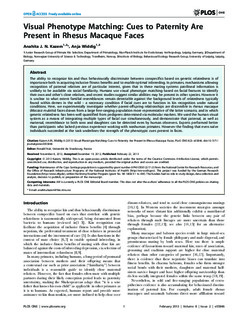| dc.contributor.author | Kazem, Anahita J. N. | |
| dc.contributor.author | Widdig, A | |
| dc.date.accessioned | 2015-11-20T10:57:56Z | |
| dc.date.accessioned | 2016-05-10T08:41:02Z | |
| dc.date.available | 2015-11-20T10:57:56Z | |
| dc.date.available | 2016-05-10T08:41:02Z | |
| dc.date.issued | 2013-02-22 | |
| dc.identifier.citation | PLoS ONE 2013, 8(2) | nb_NO |
| dc.identifier.issn | 1932-6203 | |
| dc.identifier.uri | http://hdl.handle.net/11250/2388894 | |
| dc.description.abstract | The ability to recognize kin and thus behaviourally discriminate between conspecifics based on genetic relatedness is of
importance both in acquiring inclusive fitness benefits and to enable optimal inbreeding. In primates, mechanisms allowing
recognition of paternal relatives are of particular interest, given that in these mating systems patrilineal information is
unlikely to be available via social familiarity. Humans use visual phenotype matching based on facial features to identify
their own and other’s close relatives, and recent studies suggest similar abilities may be present in other species. However it
is unclear to what extent familial resemblances remain detectable against the background levels of relatedness typically
found within demes in the wild – a necessary condition if facial cues are to function in kin recognition under natural
conditions. Here, we experimentally investigate whether parent-offspring relationships are discernible in rhesus macaque
(Macaca mulatta) faces drawn from a large free-ranging population more representative of the latter scenario, and in which
genetic relatedness has been well quantified from pedigrees determined via molecular markers. We used the human visual
system as a means of integrating multiple types of facial cue simultaneously, and demonstrate that paternal, as well as
maternal, resemblance to both sons and daughters can be detected even by human observers. Experts performed better
than participants who lacked previous experience working with nonhuman primates. However the finding that even naı¨ve
individuals succeeded at the task underlines the strength of the phenotypic cues present in faces. | nb_NO |
| dc.language.iso | eng | nb_NO |
| dc.publisher | Public Library of Science | nb_NO |
| dc.rights | Navngivelse 3.0 Norge | * |
| dc.rights.uri | http://creativecommons.org/licenses/by/3.0/no/ | * |
| dc.title | Visual Phenotype Matching: Cues to Paternity Are Present in Rhesus Macaque Faces | nb_NO |
| dc.type | Journal article | nb_NO |
| dc.type | Peer reviewed | nb_NO |
| dc.date.updated | 2015-11-20T10:57:56Z | |
| dc.source.volume | 8 | nb_NO |
| dc.source.journal | PLoS ONE | nb_NO |
| dc.source.issue | 2 | nb_NO |
| dc.identifier.doi | 10.1371/journal.pone.0055846 | |
| dc.identifier.cristin | 1029416 | |
| dc.description.localcode | © 2013 Kazem, Widdig. This is an open-access article distributed under the terms of the Creative Commons Attribution License, which permits unrestricted use, distribution, and reproduction in any medium, provided the original author and source are credited. | nb_NO |

